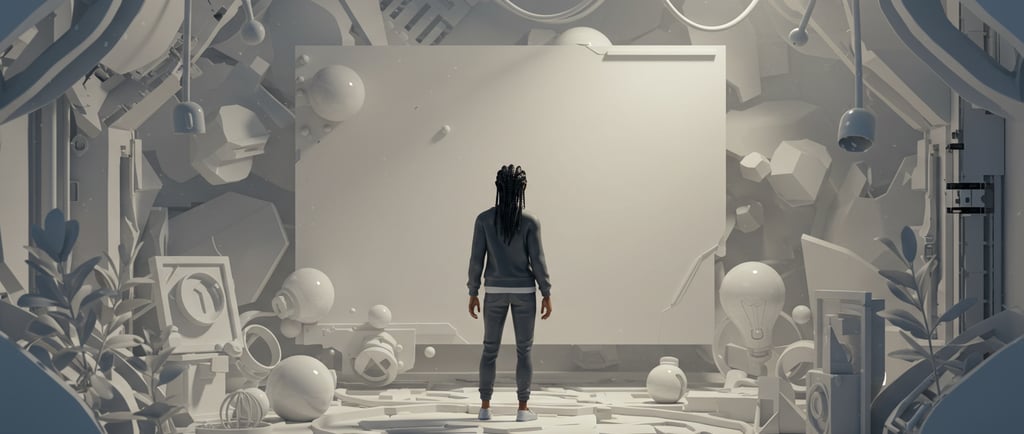AI Creativity: Human and AI Collaboration
Fusing Human Creativity with AI's Precision and Excellence. No longer are creatives paying for writer’s block, brainstorming, or hand-coding. They leverage AI capabilities to spawn ideas, which are evolved and delivered using Human and AI collaboration.
AI X HUMAN
5/31/20252 min read


The End of Creative Paralysis
Let’s be honest: even the most brilliant minds hit a wall. Whether you’re naming a brand, plotting a storyboard, designing an interface, or writing copy, the pressure to “be creative on command” has always been a heavy lift.
Now, tools like ChatGPT, Notion AI, Midjourney, and DALL·E 3 are helping creatives bypass the inertia. With a single prompt, you can generate 20 naming directions, 10 visual styleboards, or a week’s worth of ad copy—all in seconds.
Conclusion: A New Creative Era
We’ve moved beyond the question, “Will AI replace designers?” The reality is, AI empowers designers—removing friction, speeding up production, and enhancing quality.
This isn’t man vs. machine. It’s human x AI.
And the future of creativity belongs to those who embrace that collaboration.
“AI doesn’t give you the final answer. It gives you the momentum.”
How the Human + AI Workflow Looks in Practice
The creative process has evolved from linear to co-creative. Here’s what that looks like:
1. Prompt
The designer, writer, or strategist initiates the creative process with a brief, prompt, or vision.
Example: “Generate logo concepts for a sustainable fashion brand targeting Gen Z.”
2. Generate
AI responds—instantly. It provides a range of outputs: visuals, phrases, layouts, ideas.
Tools like Firefly, Uizard, or Framer AI can deliver a wireframe, while Midjourney gives you brand moodboards in real time.
3. Curate
The human steps back in. They review, critique, remix, and redirect the AI’s output. This is the soul-work—the intuitive, contextual decisions machines can’t replicate.
4. Refine
Back and forth, the AI helps refine the chosen direction: adjusting colors, language, layout, motion, or flow.
5. Finalize & Ship
With fewer bottlenecks and faster iteration cycles, the final product is more polished, timely, and aligned than ever.
This workflow cuts production time by days or weeks—and unlocks more creative exploration, not less.
Why AI Collaboration Is a Game-Changer for Creatives
🔁 Infinite Iterations, Zero Burnout
Need 50 landing page variations for A/B testing? AI has you covered. You decide which ones work—and why.
🎯 From Precision to Personalization
AI can generate hyper-specific visuals, user flows, and copy tailored to micro-audiences. That’s personalization at scale.
🧠 Idea Generation on Tap
You’re never out of ideas. You’re just one smart prompt away from a new creative spark.
💡 Creative Confidence
With AI handling execution-heavy tasks, designers can focus on storytelling, strategy, and innovation—what they do best.
Where It’s Already Transforming the Industry
✏️ Branding & Identity
Agencies use generative AI to produce dozens of visual directions, logo styles, and tone-of-voice options before finalizing identity systems.
💻 UX/UI Design
Tools like Figma AI and Uizard are automating wireframes, layouts, and even developer handoff documentation.
📹 Video & Motion Design
With Runway ML, motion designers are generating B-roll, background replacement, and even AI-acted scenes with little more than a script.
🎨 Fashion, Architecture & Art
Platforms like KREA AI and Vizcom allow creators to turn simple sketches or style prompts into high-resolution, on-brand visuals or renders—ideal for pitching or moodboarding.
The Ethical Edge: Still a Human Job
While AI is becoming a powerful co-creator, ethical boundaries are still drawn by humans. Designers and artists remain the decision-makers, the taste-makers, and the storytellers. The best results come not from blindly accepting AI outputs, but from critiquing, guiding, and reshaping them.
AI might know how to generate beautiful. Only you know how to make it meaningful.
